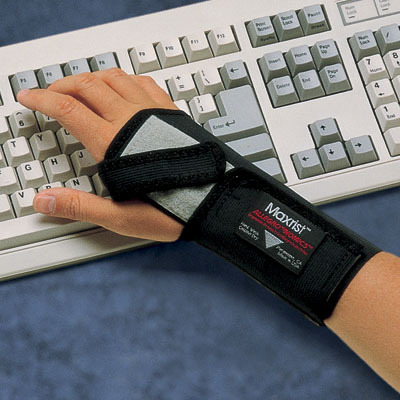Why Wear a Wrist Support
Carpal tunnel syndrome is a disturbingly common nerve disorder. Estimates by the American College of Rheumatology suggest that between four and 10 million people suffer from this disorder in the U.S. alone. Fortunately, carpal tunnel syndrome is highly treatable, with one of the most common and effective methods of treatment being regularly wearing a wrist support. Many people who routinely wear an appropriate wrist support, in conjunction with other treatments prescribed by a physician, are able to make a complete recovery. This means being able to enjoy work, play and exercise without having to be troubled by the pain and lack of function that comes with carpal tunnel syndrome.
Have you ever experienced numbness, pain, tingling or weakness in one or both of your hands? If so, then you may have been experiencing the symptoms of carpal tunnel syndrome. The symptoms often take people by surprise, especially because they tend to show up at night, long after work is over for the day. Some people may even be awakened by the pain and tingling in the middle of the night. It's common for those in the early stages of the disorder to shake their hand when the symptoms come on. This may provide temporary relief, but it is not an effective treatment method.
Carpal tunnel syndrome occurs when the median nerve in the wrist is put under pressure. A number of tendons run along your forearm and into your hand along with the median nerve. The tendons and nerve are enclosed in the carpal tunnel. Swelling in the wrist puts pressure on the carpal tunnel, causing the discomfort that is often associated with the syndrome. Certain medical conditions like diabetes and rheumatoid arthritis can cause carpal tunnel syndrome. However, most people suffer from this disorder as a result of their daily activities.
Repetitive hand movements that cause the hands to be in a lower position than the wrists are probably the most frequent cause of carpal tunnel syndrome. The disorder shows up in a broad range of industries and occupations. Everyone from office workers to warehouse personnel is susceptible. Wherever workers are asked to make the same motions over and over again or where ergonomic measures have not been put into place, carpal tunnel syndrome is all but certain to follow.
The Bureau of Labor Statistics found that approximately one third of all worker injuries and illnesses in 2011 were caused by musculoskeletal disorders like carpal tunnel syndrome. Workers with this disorder came from a variety of industries like health care, construction, transportation, warehousing and more. The need to take action is clear.
Workers and their employers can take a number of steps to prevent the development of carpal tunnel syndrome and other repetitive stress injuries. Education regarding the early symptoms of the syndrome will encourage catching the disorder long before it becomes more severe. Training about how to work ergonomically can also make a huge difference as can providing ergonomic tools and work stations. Rotating jobs so that no one has to do the same repetitive task without respite is similarly a sensible measure. However, wearing a simple wrist support may be the most important thing workers can do to protect themselves and prevent further injury.
Wearing wrist supports makes pretty nearly any activity ergonomic. The wrist support acts like an additional ligament. It limits the ability of the wrist to flex or extend, meaning that the wrist must remain in a neutral position. This neutral position is exceptionally ergonomic, and although the wrist does not have full range of motion, the fingers remain completely liberated. This means that the employee can work with a minimum of stress on their wrist and still have the manual dexterity that their job may require.
Quality wrist supports all have certain characteristics in common. They are easy to put on and just as easy to remove. Velcro makes the ideal closure method. It's sturdy and reliable and doesn't require frequent adjustment. However, adjustability is one of the hallmarks of a great wrist support. Workers should always be able to adjust the fit to suit the task and their level of comfort. Fabrics must be durable while also maintaining breathability. It may be especially important for the wrist supports to have a wicking layer that moves moisture away from the skin for the ultimate in comfort.
Some workers prefer a wrist support that has a thumb loop. This essential feature helps to keep the wrist strap in place while also offering an additional level of support. Many workers who wear wrist supports swear by the thumb loop as a simple addition that can make a huge difference in their comfort level.
Wrist supports may be worn only at work, but some people need round-the-clock relief. Fortunately, wrist wraps and braces can be worn all day and night. People with carpal tunnel syndrome often find it helpful to sleep with the brace on as it prevents them from bending their wrist while sleeping at night. The wrist support also may be a welcome addition to any fitness or sports activities.
Carpal tunnel syndrome and other repetitive stress injuries are all-too common in the U.S. Several treatments are available, and one of the most effective of these is wearing wrist supports. Adjustable, durable, breathable wrist supports may be the key to putting carpal tunnel syndrome behind you for good.

